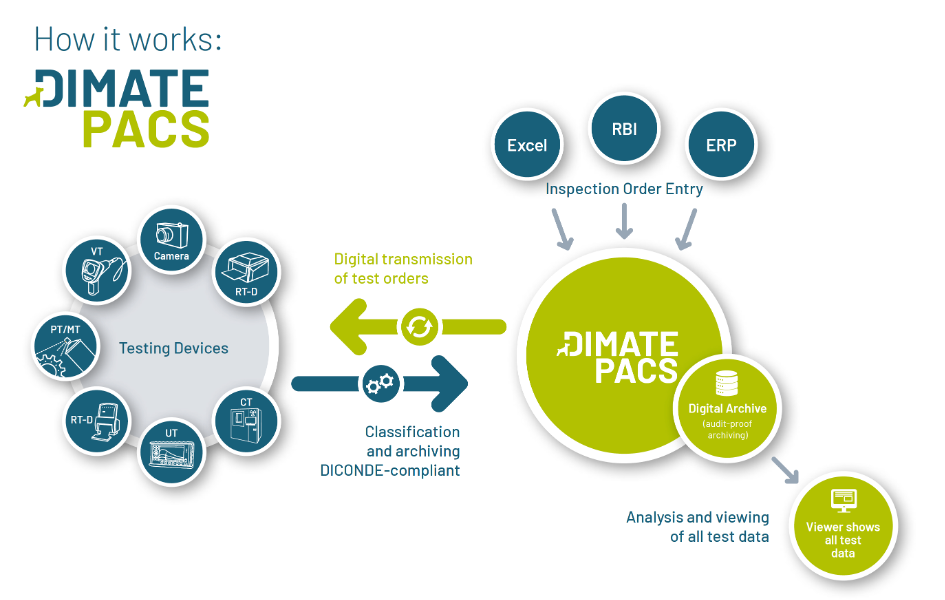What is a NDT-PACS and what do you get out of it?

The heart of a PACS is the PACS server. This is where the image data of the testing equipment – independent of manufacturer or modality – is stored in an audit-proof manner. Audit-proof means that all storage requirements for digital data and documents are being complied with.
What’s this DICONDE thing?
For digital image data of all modalities and manufacturers to be accepted by and processed in a single system, they all have to speak the same language. That means the data has to be available in a single, unified format – also called standard. That’s very much like audio or photo files where formats such as MP3 or JPG have become “standard” so that all kinds of contents can be listened to or watched on any device and in any application. In NDT this standard is called DICONDE (Digital Imaging and Communication in Non-Destructive Evaluation) – it makes sure that images from any source can be processed and archived in and by any software package.
DICONDE is an ASTM standard and covers all NDT procedures such as x-ray, ultrasound, and any other visual inspection.
And how do images in DICONDE get into the PACS? There are two answers to this question: either the device that acquires the image directly creates DICONDE data which is transmitted to the PACS or the device that acquires the image creates non-DICONDE data which is transmitted to the PACS and the PACS converts it to DICONDE. Either way: you as the user got it easy since you don’t have to worry about feeding the PACS with the correct format. The PACS will take care of everything.
One software, many benefits
In NDT, handling digital image data requires sophisticated software, firstly because the enormous volume of the files and the subsequent storage capacity and secondly because the software has to ensure that the data is loaded quickly. In short: performance is essential. Nobody has five minutes to waste until a test image is pulled from the archive.
There is another important issue: the PACS server provides the image data not only within the perimeter of your company but ideally also to your customers or any other external party. In short: extremely high reliability is also essential.
That all sounds horribly cumbersome but in fact the integration of a PACS into an existing IT structure is rather easy. And even the necessary resource investment is reasonable considering the benefits:
- Only a single archive has to be procured and maintained
- All test information is available in a single system
- Staff has to be trained only on one system
Measure, filter, analyze
A PACS to be sure does not only consist of the server but encompasses an application for viewing, processing and analyzing the digital images. Very often you will hear the term “work station” which is a bit misleading since it is “only” a software that can be loaded onto a computer. No need to set-up a dedicated desk with a screen and computer.
On this workstation or rather in the software the testers and inspectors will find all functions for analyzing the test images. Digital analysis is faster and more precise since the images can be calibrated and measured and filters can be applied to optimize the images. Moreover, several images can be checked in parallel and over time to identify changes.
But not only testers and inspectors can access the image and test data. Experts who are asked to offer a second opinion, customers, regulators and notified bodies can quickly and safely call up the data. One of the major advantages of digital images is the fact that they can be viewed by several parties at the same time and at different locations.
Thus, the PACS enables decentralized work – a boon in these pandemic times when testers and inspectors perform their tasks from the home office. Today, the image is available wherever and whenever it is needed. And it goes without saying that the PACS protects the data from unauthorized access.
In a nutshell: a PACS is pretty ingenious
You would like to experience our DIMATE PACS before you make a decision? No problem whatsoever. Just get in touch with us!
